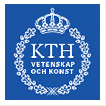

 |
MSc. Cognitive Science (HCI), Lund University 2007-2008
The dream of touch free computer interaction was realized within the one year masters program at Lund University.
After initial courses in Cognitive Science, Neuroscience and Eye Tracking Methodology I constructed the NeoVisus Gaze
Interaction interface (demonstration video) that enables one to control a computer simply by looking at the screen.
In addition to the research and development I published a wide range of relevant information on the Gaze Interaction Blog
|
- MSc. Thesis : NeoVisus Gaze Interaction
- Cognitive Neuroscience
- Eye Tracking Methodology
This thesis investigates suitable interaction methods for gaze driven computer interfaces. The lack of input devices requires interface components that are especially designed to be driven by gaze input. A set of reusable and configurable interface components were developed to support various interaction styles. The components were then used to build a prototype application containing a game, a photo viewer and a music player. An evaluation of the interface components as well as the prototype application was performed. The use of dynamically appearing target areas for saccadic selection was found to be a suitable interaction method for gaze driven interfaces. The interaction methods helps to alleviate the previously found stress associated with gaze driven interfaces (the midas touch problem). Overall the prototype application received a positive response from the evaluation participants with appreciation for being intuitive to use.

 |
University of California, San Diego 2006-2007 Selected for a one year EAP exchange program for further specialization. Given my strong interest in user centred software development I choose to endeavor in Cognitive Science with focus on human-computer interaction, cognitive engineering / design. To further develop my technical skills I took the upper division Computer Science class "Enterprise-class web applications" where we developed the Web(e)lerts system using J2EE, Struts, AJAX and open source s/w. |
- Introduction to Cognitive Science
- Minds and Brains
- UCSD Course website Lecturing by Dr. Mary Boyle
- T.A - Minds and Brains Instructional Apprentices (IA199)
- Neurobiology of Cognition
- UCSD Course website Lecturing by Dr. Mary Boyle
- Cognitive Engineering
- Systems Neuroscience
- UCSD Course website lecturing by Prof. Marty Sereno
- Cognitive Neuroscience
- UCSD Course website Lecturing by Associate Prof. Andrea A. Chiba
- Human Computer Interaction
- Enterprise-Class Web Applications
- Web(e)lerts system documentation
- UCSD Course website Lecturing by Darnell Gadberry
- Spanish Conversation
- Basic conversation in the Spanish language.
Course project "Web(e)lerts" utilizes the following:
J2EE on Apache Geronimo, Web 2.0 AJAX interfacing, Struts, Quartz Enterprise Scheduling, Rome and Aquaduct with the Prevlayer implementation.

- 610 Informatics (Software Design)
- Program construction A - Objectoriented programming
- Program construction B - Java programming
- System Development
- Computers and Networks
- 615 Informatics (Management)
- Project Management
- Group Dynamics (Pschycology)
- Organization,business and IT
- Legislation aspects on Information Technology
- 620 Informatics (Software Development)
- Program construction
- System Development
- Human-Computer Interaction
- SQL Databases
- 053 Informatics (Distributed Systems)
- Advance relational databases
- Distributed systems
- Software Development Development of a J2EE based web application running on Tomcat and MySQL. Using Java Server Faces.
- 630 Informatics Bachelor Thesis
Thesis topic and abstract The purpose of this study is to explore the area surrounding computer energy consumption. After reviewing general background on related fields we measured energy consumption among different computers and monitors. Based on the results we constructed a survey aimed at Swedish schools. Using a quantitative approach we draw some conclusions, a majority of the respondents lacked someone responsible of shutting down computers after hours; even more lacked a tool to do so. With the help of our survey result we demonstrate how organization could reduce energy waste and receive financial benefits, with a minimal effort. To enhance the power management in an environment with computer networks we introduced related techniques and describe how they operate. We then suggest a centralized solution based on open source. Our intention is to provide references and discuss several of the open source implementations that freely exist.

 |
Oracle Database Administration (1/4 DBA) 2005
|

 |
Practical programming (6 months, 1999) |
|



IT/IS 9000 Advanced field communication system (1998)
Drafted to serve for one year as a squad leader (corporal) for a five men unit in the PB8 mechanized brigade providing field communications for command and staff. Establishing ad-hoc IT/IS9000 tele/data communication networks in the wild using fiber and radio link over vast rural areas.
Specialized training
- Leadership / Group Psychology
- Alcatel Fiberopics
- Ericsson Radio Link Switches
- SCO Unix/NT server
- Encryption Hardware

Other, non-related education/training/certification:
- Swedish B-Class Driving License
- 3 Year Arts & Music Programme at Nicolaiskolan, Helsingborg (1997)
- PADI Advanced Diving Certificate

